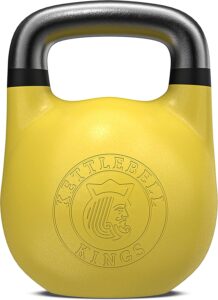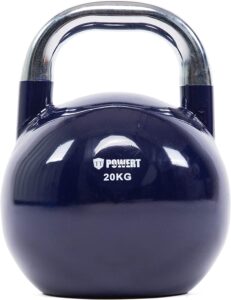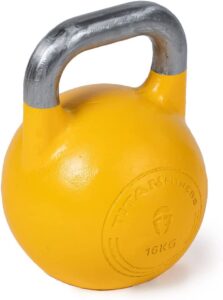
– Image by master1305 on Freepik –
As an affiliate, we earn a small commission when you make a purchase through the links in our blog post. We appreciate your support and hope you find the products helpful.
I know what you might be thinking. “Kettlebells? Aren’t those just glorified paperweights?” Oh, how wrong you are. Competition kettlebells are a whole different beast, a unique and challenging tool that will push you to your limits and leave you gasping for breath.
But don’t take my word for it. Let me tell you a little story. I was once like you, bored with my fitness routine and looking for something new. That’s when I stumbled upon a competition kettlebell class at my local gym. At first, I was skeptical. How could swinging a chunk of metal around be that challenging?
But as soon as I picked up that kettlebell, I knew I was in for a wild ride. The weight distribution, the grip, the sheer challenge of moving that thing through space…it was like nothing I’d ever experienced before. And let me tell you, the soreness the next day was proof that I’d worked muscles I didn’t even know existed.
So, if you’re looking to shake up your fitness routine, if you’re ready to try something that will challenge you both physically and mentally, then keep reading. In this post, we’ll dive deep into the world of competition kettlebells, exploring what they are, how to use them, and why they’re worth the effort. Trust me, you won’t regret it.
What are Competition Kettlebells?
Competition kettlebells are a type of kettlebell that are specifically designed and manufactured to meet standardized weight, size, and shape requirements for kettlebell sport competitions.
The shape and dimensions of competition kettlebells are consistent across all weights, with a uniform diameter at the base, a rounded top, and a curved handle that is attached to the body of the kettlebell.
Weight and Size Standards
The weights of competition kettlebells are standardized, with men’s weights ranging from 8kg (17.6 lbs) to 48kg (105.6 lbs) and women’s weights ranging from 8kg (17.6 lbs) to 32kg (70.4 lbs).
The weight increments for competition kettlebells are smaller at the lower end of the spectrum, with 2kg (4.4 lbs) or 4kg (8.8 lbs) increments between weights up to 24kg (52.9 lbs), and 4kg (8.8 lbs) increments between weights up to the maximum weight for each gender.
The size of the competition kettlebell, on the other hand, varies depending on its weight. The shape and dimensions of the kettlebell are consistent across all weights, with a uniform diameter at the base, a rounded top, and a curved handle that is attached to the body of the kettlebell.
The dimensions and shape of competition kettlebells are carefully designed to ensure optimal performance, safety, and consistency during kettlebell sport competitions.
What are Competition Kettlebells Made of?
Competition kettlebells are typically made of high-quality materials that are durable and long-lasting. The most common materials used in the construction of competition kettlebells are steel or iron.
These materials provide the necessary weight and strength for the kettlebell, while also being resistant to wear and tear. The surface of competition kettlebells is often coated with a finish that is smooth and free of any rough spots or seams that could cause discomfort or blisters during use.
7 Benefits of Using Competition Kettlebells
Increased grip strength: Competition kettlebells require a stronger and more stable grip due to their uniform shape and smooth finish, which can help improve grip strength over time.
Improved technique: Competition kettlebells have a consistent size and shape, which can help promote good form and technique during movements like swings, snatches, and cleans.
Challenging workout: The standardized weight increments and consistent design of competition kettlebells make them ideal for progressive overload, providing a challenging workout for both strength and endurance training.
Reduced risk of injury: The high-quality materials and uniform shape of competition kettlebells can help prevent blisters, calluses, and other injuries commonly associated with using traditional kettlebells.
Versatility: While designed for kettlebell sport competitions, competition kettlebells are also well-suited for general fitness training, making them a versatile option for a wide range of exercises.
Improved cardiovascular health: Kettlebell exercises, particularly when performed with competition kettlebells, can provide a cardiovascular workout that helps improve heart health and endurance.
Fun and engaging: The unique shape and design of competition kettlebells can make training with them more enjoyable and engaging than traditional gym equipment, leading to a more sustainable fitness routine.
Top 3 Best Competition Kettlebells
Kettlebell Kings

FEATURES
- 8 - 48 Kg for Men & Women
- Premium Quality
- Lifetime warranty & free workouts
- Over 100 Five Star Amazon Seller Reviews
POWERT

FEATURES
- 8 - 28 Kg for Men & Women
- Premium Quality Coated Steel
- Ergonomic Design
- Color-coded design
Ader Pro-Grade

FEATURES
- 8 - 32 Kg for Men & Women
- Unpainted Handle for a Better Grip
- Ergonomic Design
- High Quality
Top 5 Most Popular Competition Kettlebell Exercises
There are many exercises that can be performed with competition kettlebells, but some of the most effective and popular ones include:
Kettlebell swing: This exercise targets the glutes, hamstrings, and lower back while also providing a cardiovascular workout.
2. Clean and press: This exercise targets the shoulders, triceps, and upper back while also engaging the core and lower body.
3. Turkish get-up: This exercise involves multiple movements that target the shoulders, core, hips, and legs while also improving balance and coordination.
4. Snatch: This exercise targets the shoulders, upper back, and core while also providing a cardiovascular workout.
5. Goblet squat: This exercise targets the quadriceps, glutes, and core while also improving flexibility and mobility.
These exercises can be incorporated into a variety of training programs and routines for competition kettlebell training. It is important to choose exercises that are appropriate for your fitness level and to use proper form and technique to avoid injury.
Safety Considerations
Safety considerations are also important when using competition kettlebells, as the high-repetition movements and heavy weights can put significant stress on the body. It’s important to start with a weight that you can safely lift and perform the exercises with proper form, and to gradually increase the weight as you become more experienced and proficient.
It’s also important to warm up properly before training, and to use proper technique and form throughout each exercise to avoid injury.
Finally, it’s recommended to work with a qualified trainer or coach who can provide guidance and support as you develop your kettlebell training skills and abilities.
FAQ
How to choose the correct kettlebell weight?
To choose the correct kettlebell weight, consider your fitness level, goals, and current strength. Test your weight by performing a few reps of your chosen exercise. It’s always better to start with a lighter weight and work your way up gradually.
Are competition kettlebells better than regular kettlebells?
It depends on your goals and preferences. Competition kettlebells are designed to meet specific standards for competitions, while regular kettlebells are more commonly used for general fitness and strength training. Both can be high-quality and durable if made properly. Choose the type of kettlebell that suits your needs and goals.
What is the heaviest competition kettlebell?
The heaviest competition kettlebell weight is 48kg (106 lbs) for men and 32kg (70 lbs) for women. These weights are used in kettlebell sport competitions for the snatch and jerk events. However, not all competitions offer these weights, and they are typically reserved for advanced athletes who have trained with kettlebells for a significant amount of time.
What is the difference between a kettlebell and a competition kettlebell?
The main difference between regular and competition kettlebells is their design and intended use. Competition kettlebells have a standardized size, shape, and handle width for kettlebell sport competitions, while regular kettlebells are more versatile and come in a wider variety of sizes, shapes, and materials. Competition kettlebells are typically more expensive due to their consistent design and higher quality materials.
How many pounds do competition kettlebells weigh?
Competition kettlebells are typically measured in kilograms (kg), as they are designed to meet international standards for kettlebell sport competitions. The weight range for competition kettlebells is typically between 8kg (17.6 lbs) to 48kg (106 lbs) for men and 8kg (17.6 lbs) to 32kg (70 lbs) for women. However, not all competitions offer the full range of weights, and athletes are required to compete with specific weights in each event.
Final Thoughts
In conclusion, competition kettlebells can be a valuable addition to your fitness routine, whether you’re a competitive athlete or just looking for a fun and challenging workout. They offer a consistent weight and size, which can help improve your technique and form, and their durable construction ensures they can withstand frequent use.
To get the most out of your kettlebell workouts, it’s essential to focus on proper technique and form. This means starting with lighter weights and gradually increasing your weight and intensity over time to avoid injury and ensure maximum benefits. Whether you choose a regular kettlebell or a competition kettlebell, the key is to find a weight that challenges you without compromising your technique.
So go ahead and give competition kettlebells a try – they’re a versatile and effective tool for building strength, improving endurance, and taking your fitness to the next level!